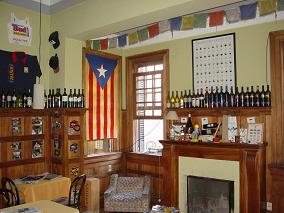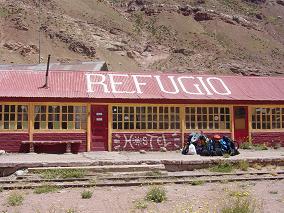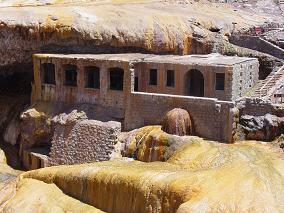
|
To and From the Mountain |
Fuel, Stoves, and the TSA

|
ommercial airline flights and mountaineers don't mix. Crampons, ice axes, pocketknives, incendiary devices (butane lighters, matches), and cooking fuel are all on the TSA (Transportation Security Administration) hit list.
On an international journey stove confiscation is a serious concern. TSA personnel are not known for their brilliance, and, faced with a stove purged of fuel they find it difficult to follow their own rules and give the nod for its safe transport in check-through luggage. Once the stoves are gone you can probably say sayonara to a successful ascent.
Edward and John dismantle their Whisperlight Internationale stoves prior to flying south. I maintain the opinion that, upon finding strange metal parts in luggage, a TSA moron might think the worst and consider them to be parts of a weapon. I have witnessed similar cases of illogic - after all, since the parts are inaccessible in-flight, what is the risk of an assembled weapon in the first place?
All four stoves arrive, and at our Mendoza hostel the two dismantled stoves are reassembled and tested.
The stoves are all brought to Base Camp (as mules transport them); and we enjoy the luxury of one stove per person. Above Base Camp we bring two stoves - one to melt snow while the other heats water for cooking. You must bring at least two stoves for a multi-person climb in case one of them suffers mechanical failure.
At one point in Base Camp, Edward's and John's stoves do not function owing to loosened parts. My left eyeglass lens falls out of the metal frame; and, on the post-climb return to Puente del Inca, assorted food containers have their contents spill inside our backpacks. The point of commonality is the jostling atop mules for mile after bumpy mile of hiking trail. You are hereby advised of this fact, and are cautioned to make the appropriate modifications in how your belongings are packed.
To the Mountain

|
he necessity of purchasing a climbing permit in-person from Mendoza severely restricts travel options for getting to Aconcagua Provincial Park.
We fly to Santiago, Chile and then, remaining within the airport, fly to Mendoza, Argentina. This plan avoids a $100 country entry fee levied on American travelers by the Chilean authorities. It also avoids potential confiscation of dairy and meat products by their agricultural inspectors.
We spend a night at Mendoza's Hostel Independencia. The bunk room sets us back all of $30. The address is Avenida Mitre 1237; Telefax (54 261) 423-1806.

|
| The interior of Hostel Independencia. |
Mendoza supermarkets have most of the food needed for an Aconcagua expedition. Exceptions are few, including maple syrup and other minor items. However we bring nearly all our food from the states to be absolutely certain of reliable calorie sources for the climb.
Purchase as much as feasible prior to flying so as to minimize the amount of time required for these tasks while in Mendoza. Stated differently, every hour spent in Mendoza, not acclimatizing, is more valuable than the same hour spent at home simply buying food.
However some purchases are made in Mendoza for practical reasons - including a pound of butter and fourteen liters of white gasoline for cooking and melting snow for water.
You should always err on the high side when estimating fuel requirements on an expedition because it is nearly impossible to ration fuel if in short supply. For the Ruta Normal we plan upon one gallon per person, so calling for fifteen liters total. Fourteen liters are purchased because the containers were available only in a two-liter size.
The next morning we obtain our climbing permits and drive a van contracted by Mallku Expediciones for transportation to Puente del Inca.
We lodge at a ramshackle, red-roofed hostel at the backside of Puente del Inca ("Inca bridge"), close to the raging river and the ancient, yellow-tinged Inca ruins. The price is 20 pesos per person per night - about seven dollars. You get a bunk bed and precious little area to organize your array of food, clothing, and climbing gear. Indeed, your equipment is best left in the entrance hallway because the rooms themselves lack the area (and bright light) to organize one's gear.

|
| Our refugio at Puente del Inca. |
Breakfast is free, and one may use the kitchen until it closes late at night. The ambience is "funky", with the operator, Federico, sporting a wild hair style that only a punk rock star can appreciate.
In the kitchen is a book for visitors to stamp their mark. On return from the summit I avail myself of this opportunity to pen a note to Estimado Aconcagua ("great Aconcagua") - in Spanish.
There is also a book for recording favorite recipes. One American entry, complete with stars and stripes, calls for chocolate chip cookies. I am more enlightened by the exotic, foreign entries.
An elegant hotel (by Aconcagua standards) lies immediately along the highway. However at some $40 a night one must be quite desperate for a comfortable room to actually stay there.
One may hire a driver for a transfer, i.e. motorized transport from Puente del Inca to the Horcones Valley park entrance. This costs only a few dollars - and yet we forsake this option to ensure a 14,000 foot net elevation gain on-foot. The relevant hike is all of four kilometers (2 1/2 miles), entails a 500 foot elevation gain, and consumes 45 minutes.
From the Mountain

|
fter our climb there is no need for a Mendoza revisit. We thus drive west by public bus directly to Santiago. Ticket purchases are made at Snack Bar, a café in Puente del Inca that also sells posters of Aconcagua and much snack food - including ice cream. My pint of dulce de leche ("caramel") ice cream is complemented with leftover granola bar pieces and assorted dried fruit.
Purchase the tickets before the bus departs Mendoza, providing names and passport numbers to the lady behind the snack counter. She then phones-in the information, and the driver will expect your presence when the bus passes by some three or four hours later.

|
|
Ancient ruins at Puente del Inca sit alongside the river. |
On the bus drive after crossing into Chile, we pass an overturned truck transporting vino tinto ("red wine"). The driver stops and most passengers, including myself, collect unbroken bottles lying on the road. A police vehicle with siren forces a quick end to this mayhem. I place my bottle on the curb and enter the bus.
Once driving, a man passes around his bottle for all to partake. I sip a little bit through a straw because my lips hurt too much from a Herpes viral infection stemming from the high altitude.
The virus lives in nerve ganglia, making its presence known when the host is compromised from stress - here as extreme altitude and the corresponding large doses of ultraviolet radiation. The lip problem begins around summit day. At times I am challenged to eat normally, electing to cut food into pieces small enough that they fit into my mouth without touching the lips.
This is not a simple case of chapped lips. At first acidic food and salt are forbidden fruits. After a few days anything touching the lips is painful. One night, back at Puente del Inca, "dinner" consisted of a brownie with milk because I was afraid to eat a restaurant meal with the other team members. It takes two weeks for my lips to completely heal.
On arrival at the Terminal Sur bus station I walk to RedBank - an ATM machine located behind a locked, transparent booth amidst a sea of human activity. After securing 100,000 Chilean pesos (about $200), I run from the booth lest somebody rob me. A security officer approaches and asks why I am running. I explain in Spanish that I did not know the threat level from thieves, and so hedge my bet by moving as quickly as possible.
We arrive at our destination, an unremarkably appearing hostel, sometime after 8 p.m.
| previous page - Logistical Support | next page - SCS Habitat ("Scott's Place") |